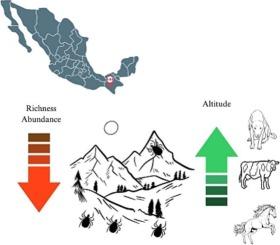墨西哥南部不同海拔地区与家畜有关的蜱虫的丰富性和丰度
IF 1.4
Q3 PARASITOLOGY
Veterinary parasitology, regional studies and reports
Pub Date : 2024-10-16
DOI:10.1016/j.vprsr.2024.101136
引用次数: 0
摘要
这项研究的目的是确定从恰帕斯州墨西哥南部太平洋沿岸五个城市和十六个不同社区的家畜身上采集的蜱虫的丰富度、丰度和海拔分布情况。蜱虫样本来自每个地区的狗、马和牛。共采集了 311 个宿主样本,其中 264 个(85%)是狗,26 个(8%)是马,21 个(7%)是牛。在这些宿主中,分别有 83 只(26 %)、17 只(5 %)和 7 只(2 %)被感染。共采集到 583 只蜱虫,代表 4 个属和 6 个种。最常见的种类是 Rhipicephalus linnaei(68.61 %,n = 400),其次是 Rhipicephalus microplus(0.51 %,n = 3)、Amblyomma ovale(1.71 %,n = 10)、Amblyomma mixtum(1.71 %,n = 10)、Ixodes ci. boliviensis(2.22 %,n = 13)和 Dermacentor dissimilis(25.21 %,n = 147)。在已发现的蜱虫中,A. mixtum、A. ovale、R. microplus 和 R. linnaei 分布在海拔 0 至 1000 米的地区,而在海拔 1000 至 2000 米的地区,只发现了 I. ci. boliviensis 和 D. dissimilis 两种蜱虫。对每个地点的特征进行了讨论,以解释蜱虫的数量,并评估其作为公共卫生病原体载体的潜在风险。本文章由计算机程序翻译,如有差异,请以英文原文为准。

Richness and abundance of ticks associated with domestic animals at different altitudes in Southern Mexico
The objective of this study was to determine the richness, abundance, and altitudinal distribution of ticks collected from domestic animals in five municipalities and sixteen distinct communities along the Pacific coast of southern Mexico in Chiapas. Ticks were sampled from dogs, horses, and cows in each range. A total of 311 hosts were sampled, of which 264 (85 %) were dogs, 26 (8 %) were horses, and 21 (7 %) were cows. Of these, 83 (26 %), 17 (5 %), and 7 (2 %) hosts were infested, respectively. A total of 583 ticks were collected, representing four genera and six species. The most prevalent species was Rhipicephalus linnaei (68.61 %, n = 400), followed by Rhipicephalus microplus (0.51 %, n = 3), Amblyomma ovale (1.71 %, n = 10), Amblyomma mixtum (1.71 %, n = 10), Ixodes ci. boliviensis (2.22 %, n = 13), and Dermacentor dissimilis (25.21 %, n = 147). Of the identified ticks, A. mixtum, A. ovale, R. microplus, and R. linnaei were distributed at elevations between 0 and 1000 m, while at elevations between 1000 and 2000 m, only the species I. ci. boliviensis and D. dissimilis were found. The characteristics of each locality are discussed in order to explain the abundance of ticks and to assess their potential risk as vectors of public health pathogens.
求助全文
通过发布文献求助,成功后即可免费获取论文全文。
去求助
来源期刊
CiteScore
2.90
自引率
7.10%
发文量
126
审稿时长
97 days
期刊介绍:
Veterinary Parasitology: Regional Studies and Reports focuses on aspects of veterinary parasitology that are of regional concern, which is especially important in this era of climate change and the rapid and often unconstrained travel of people and animals. Relative to regions, this journal will accept papers of the highest quality dealing with all aspects of disease prevention, pathology, treatment, epidemiology, and control of parasites within the field of veterinary medicine. Also, case reports will be considered as they add to information related to local disease and its control; such papers must be concise and represent appropriate medical intervention. Papers on veterinary parasitology from wildlife species are acceptable, but only if they relate to the practice of veterinary medicine. Studies on vector-borne bacterial and viral agents are suitable, but only if the paper deals with vector transmission of these organisms to domesticated animals. Studies dealing with parasite control by means of natural products, both in vivo and in vitro, are more suited for one of the many journals that now specialize in papers of this type. However, due to the regional nature of much of this research, submissions may be considered based upon a case being made by the author(s) to the Editor. Circumstances relating to animal experimentation must meet the International Guiding Principles for Biomedical Research Involving Animals as issued by the Council for International Organizations of Medical Sciences (obtainable from: Executive Secretary C.I.O.M.S., c/o W.H.O., Via Appia, CH-1211 Geneva 27, Switzerland).

 求助内容:
求助内容: 应助结果提醒方式:
应助结果提醒方式:


